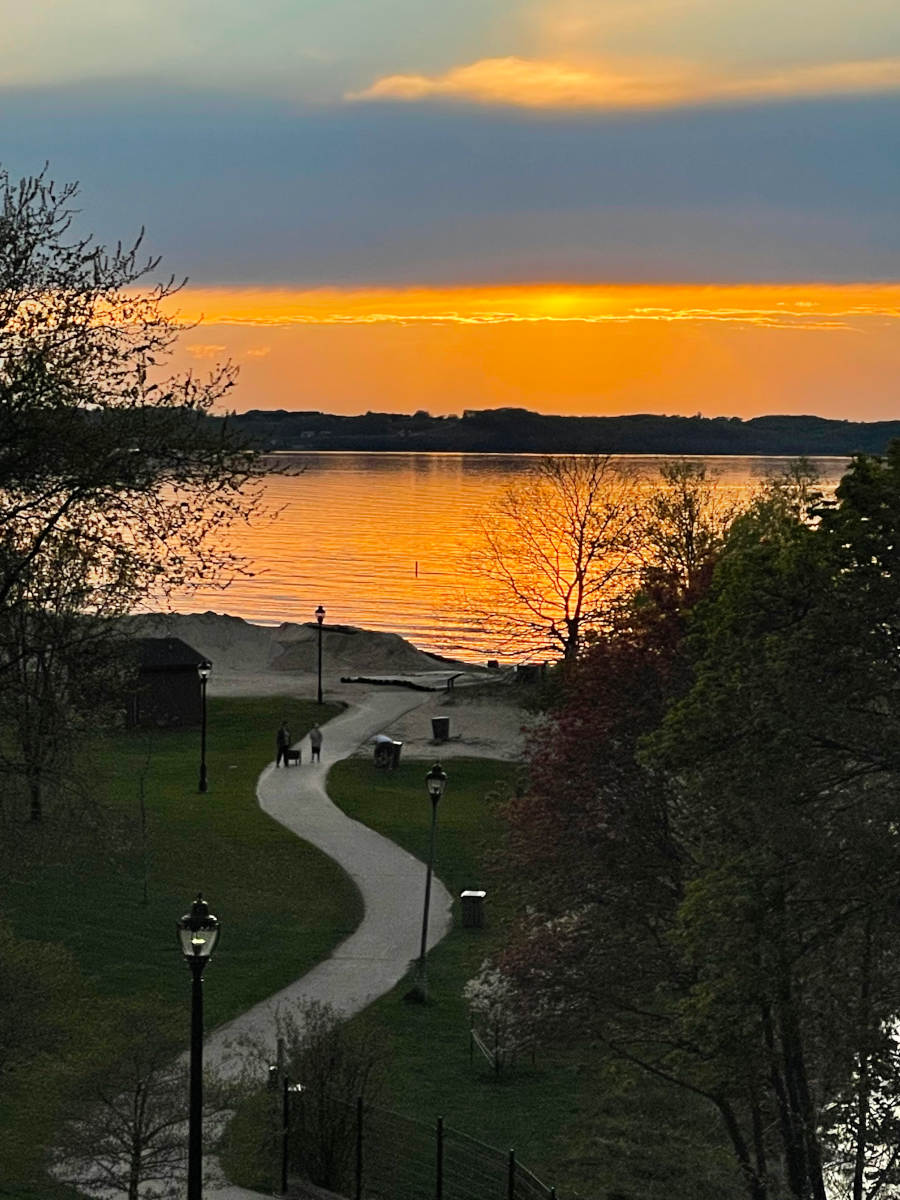
Our small town of Elk Rapids (ER), Michigan is embarking on a bold experiment. We are seeking to find common ground across divides while welcoming healthy conflicts and respectful disagreements—not exactly what we are seeing around the world.
WHY? We want to demonstrate that it is possible to bridge divides in the pursuit of creating healthy, innovative, and thriving communities, and that is possible for multiple community agencies to engage constructively and collaboratively to accelerate regional economic development.
Essentially, we want to become the ideal place to live, learn, work and play.
In order to support that experiment, a group of concerned citizens formed a Coalition of the Possible to work together to improve our community.
Our goals are to:
- Sponsor Events
- Advocate Possibilities
- Promote Civility
When we formed the Coalition in the Summer of 2019, we created norms to define what civility and sustainability look like to us—HOW we want to relate to each other. We also came up with the tagline of KindER and a guiding principle: If we are conscious and intentional about being Kind, Empathic, Respectful, collaborative, open-minded, inclusive, and honest, then we can engage in more productive conversations and achieve greater possibilities together.
The Coalition of the Possible is committed to a dialog that abides by the following values:
- We look for ways to help each other succeed (we collaborate effectively, we work together to accomplish major feats).
- We treat each other with respect and kindness.
- We are open minded (we embrace new ideas).
- We place group success as a higher priority than individual achievement.
- We focus on the positive (We are hopeful and optimistic).
- We are inclusive (we welcome new people).
- We engage in open, honest, direct and productive conversations (we don’t rely on hearsay to make our decisions , we can agree to disagree without repercussions, we operate with integrity – no complaining or finger pointing).
Over the course of my life, I have studied many individuals and organizations who have had large and lasting effects in the world—people who were able to achieve what seemed impossible given the conditions in which they were living.
For example, Maimonides, Moses, Lao Tzu, Buddha, Jesus, Hildegard of Bingen, Rumi, Madame Blavatsky, Steiner, and Gurdjieff come to mind.
Two major themes seem to run through all their writing and teaching: they ask great questions and they tell great stories.
It seems to me, in our current environment, we are not living in the right questions and our narratives are suffering from what Jennifer Kavanaugh would say is Truth Decay.
Here are the questions our community of Elk Rapids is living in and the story we want to be able to tell—our vision for the future.
Questions:
- Why do we need to change?
- Who do we want to be?
- How do we work interdependently to help the community and the regional economy thrive?
- How do we bridge divides?
- What can we do to make everyone feel heard, welcomed and inspired?
The story we want to tell:
Through a process of inclusive engagement, impartial assessment, strategic development, transparent communications, and creative branding/marketing, a large majority of the people in our community worked Empathically, Respectfully and collaboratively to generate solutions that led to a sustainable and diverse community and economy.
Our process for developing that story:
- The Coalition of the Possible invited an outside expert, Doug Griffiths, to conduct two virtual town halls discussing his book, 13 Ways to Kill a Community. The first town hall was held in July, 2020, and the second in December.
- Based on the enthusiasm generated by those two meetings, in conjunction with the local Chamber of Commerce, we sought funding to hire Doug’s firm to come into town to engage citizens in conversations about the possibilities for change and to assess the town’s commitment to, capability of and cultural support for embarking on a transformational journey.
- We managed to secure financial support from the Village Council, the DDA, the Chamber of Commerce, Rotary Charities, and the Coalition of the Possible.
- Doug and his team made three visits to our community to complete the engagement and assessment phases of our transformational process. They interacted with over 300 citizens and wrote a report on their findings. You can check out the report here: https://www.elkrapidschamber.org/13-ways-project/.
- We formed an Advisory Panel to coordinate all the efforts and to ensure that each agency was working interdependently to achieve community and economic development goals. The panel consisted of the heads of Village Council, the DDA, the Chamber of Commerce, Green ER, the Planning Commission, the School District, the Downtown Elk Rapids Association, and the Library Board. Its role was to provide collaborative leadership for the project. The Chamber of Commerce played a project management role, and I served as a facilitator for the meetings. The Advisory Panel confirmed the accuracy of the problem statements and bought into the recommendations.
- Each agency head took the findings and recommendations back to their respective boards to discuss implications and to commit to actions.
- Each agency head shared the results of their respective meetings with the Advisory Panel in order to find points of interdependency. To be clear, many of these actions were already underway before the 13 Ways project, but all agencies agreed to work together to support the vision of community building and economic development through their efforts. Here is a partial list of the action commitments:
Village Council
- Attitude
- Address misinformation through communication planning
- Presume positive intent
- Communications:
- Educate boards and commission on Roberts Rules and how to communicate with public
- Distribute quarterly newsletter
- Post notifications on elkrapids.org
- Conduct a Citizen Satisfaction Survey
- Housing
- Review 2019 Housing Task Force and decide whether or not to replicate
- Have the Housing Task Force create a housing strategy by the end of 2022
- Planning
- Start the 2023 Collaborative Master Plan Process
- Work with regional organizations such as TART, Paddle Antrim and other municipalities on regional projects
- Establish time-lines for action commitments
- Diversity and Inclusion
- Encourage business community to initiate and organize an event
- Incorporate DEI training into Governance Training
- Explore ways to welcome new people into the community, e.g. new water accounts, new students at school, realtor collateral
- Governance
- Reach agreement on selection process for new commission appointments and create a pool of volunteers
- Ensure that all commissions have up-to-date by-laws and all new members get hard copies
- Other:
- Improve broad band access
- Collaborate with other agencies to explore possibilities of becoming a mural town
- Create free co-working spaces
- Identify ways to improve child care services in partnership with other agencies
- Encourage commissions to incorporate collaboration norms in all meetings
Chamber of Commerce:
- Communication
- Expand the reach of the Monday Minute newsletter and have it include more community based information so that businesses and residents have a better understanding of issues going on in the community
- Undertake a chamber membership survey to obtain a better understanding of the issues that are of concern to the business community
- Housing
- Work with the ER Housing task to create the communication tools necessary to educate the residents/businesses in the region for the need for housing that is affordable
- Work to get other organizations involved in the housing issue (e.g., Townships)
- Community Planning
- Work with the other partners in the advisory committee to ensure that a process is created to develop a community vision/strategic plan
- Diversity/Inclusion
- Research the feasibility of creating a Young Professionals Organizations (YPO) within the community
- Have a chamber board training on diversity and inclusion in the spring of 2022
- Governance
- Participate, as a board, in the community governance training that is planned by the Village of Elk Rapids for all community boards/commissions.
Downtown Elk Rapids Association (DERA)
- Governance Standards
- Amend bylaws to include term limits and officer duties. Done and approved March 17th. Two terms maximum.
- Produce Ethics Policy, Recruitment Policy, Onboarding, Ongoing Leadership Development, Conflict of Interest Policy. Establish clear consequences for instances of ethics violations. Ensure all Board members sign COI and Ethics Policy. COI Done and approved February, Ethics Policy done March 17th and approved unanimously.
- Be intentional about building Board leadership. Provide leadership training, engagement, and development opportunities when available. Ongoing as they become available. Rotary Charities to pay for some opportunities coming up.
- DEI
- Find training for DEI. Contacted Kenneth James from Muskegon CC, Director of DEI. Set lunch date in May to explore community event.
- Consider a newcomer’s program to welcome both new residents and business owners.
- Implement a process to attract and engage remote workers.
- Consider working with the Indigenous Youth group to develop a unique cultural event. We work with this group regularly and they have an event at the school in February. Could we collaborate to make that a full community event?
- Make childcare and Housing initiatives our priority. Roundtable is scheduled for April to address childcare and other early learning issues.
- Write recruitment policy to encourage participation of demographics not well represented in our government.
- Communication
- Continue to speak out on communication issues.
- Write best practices with the foundation of Rick Bellingham’s Communication Strategy. Include best practices around media and public relations. Have ready for April meeting.
- Continue biweekly updates from Board to the DERA email list. Add minutes from Board meetings.
- President and Secretary will have responsibility for communication.
- Create a well-articulated spokesperson policy by April meeting.
- Consider a yearly membership survey.
- Economic Development
- Participate in Housing Task Force. Create investment group to develop properties. Work with business owners to create seasonal work force housing – seek out developers and investors.
- Build relationships with new DDA members who may be more open and willing to work together. Develop a collective vision. Add DDA members to committees.
- Add Board Grant Committee. Consider Director opportunity.
- Implement Roundtable for business retention, attraction, and succession for March. Scheduled March 24th. Great discussion. Grid of value added business and social services was developed.
DDA:
- Communication & Marketing.
- Improve communication with DDA stakeholders, including DDA businesses, local governmental entities, and the Elk Rapids community.
- Economic Development.
- Implement policies, programs, and projects that support a year-round, sustainable, and diverse economy in Elk Rapids.
- Create public spaces that promote health, happiness, vibrancy, and connectivity within the Elk Rapids DDA districts
- Work with the Elk Rapids Area Chamber of Commerce to:
- Identify the desired outcomes of Discover Elk Rapids website and increase investment in Discover Elk Rapids website to ensure outcomes are measured and met.
- identify how the community will implement the recommendations of the 13 Ways Initiative Report and who is responsible for which implementation components.
- Work with the Village of Elk Rapids to:
- Complete the Ames Street District streetscape beautification initiative with art, plantings, street furniture, etc.
- Create subarea plans for each district for public improvements and placemaking improvements.
- Support visual gateway and wayfinding elements linking the Traditional Downtown District, Ames Street District, and US-31 Corridor. Improve wayfinding signage and directories throughout the DDA districts.
- Improve non-motorized infrastructure, including biking, paddling, and trail connections in the DDA districts.
- Improve pedestrian infrastructure, including sidewalks, bridges, crosswalks, and intersection improvements in the DDA districts, specifically Ames Street and US-31 Intersection.
- Establish governance and continuing education training for DDA board members.
- Identify how the DDA will amplify and support experiences, events, activities that support businesses in all five DDA districts.
- Identify responsibility and tasks for DDA communications and provide training and education resources to this role.
- Create actionable and collaborative economic development strategy for the DDA districts, including district-specific business mix analysis and goals for desired types to support Elk Rapids community.
- Support the Village of Elk Rapids in completing the Redevelopment Ready Certification program.
Library
- Conduct Community Needs Assessment
Elk Rapids School District
- Continue to provide world class education to our district
- Develop lifelong learners who excel in a diverse global community
- Engage with community on DEI initiatives
- Provide facilities that meet the growing needs of the school
- Provide comprehensive educational opportunities
- Provide a safe, empowering and engaging environment with high standards and expectations
- Provide transparent, consistent, and trustworthy leadership
- Increase community engagement
- Expand and improve operational capacity
Planning Commission
- Update master plan
- Hold two workshops: 1) Planning for a Master Plan, 2) Becoming an Excellent Planning Commission
- Invite participation in the master plan with Township Planning Commission and sponsor community input sessions
- Review ordinances
- Link to other community agencies to find points of interdependence
- Address issues that might hinder progress on housing development
- Stay alert to ordinances that facilitate additional housing
- Participate in task force on housing – seek specificity, e.g. set-backs
- Attend to environmental issues as they arise
- Update environmental ordinances
Green ER
- Host a Nature Fest to increase awareness of environmental issues
- Sponsor a Trash-formation contest to heighten sensitivity to recycling
- Sponsor an exhibit at the Dennos Museum in Traverse City to demonstrate what a small community can do to increase social responsibility and sustainability
- Celebrate International Earth Day on April, 2022
- Sponsor annual super-recycling
- Continue beach clean-ups
- Continue highway pick-ups
- Work with eco-club at the high school
- Contribute to ER Almanac
- Leverage our environmental savvy to position Elk Rapids as a green community
- Hold events with Indigenous Youth Group and Sunrise Academy
- Since our town is located in the middle of two Townships who play a large role in our ability to implement our plans (particularly related to regional economic development), we decided to invite people in the townships to join our Advisory Panel. We used these criteria for selection:
- The ability to have a positive influence on the Township
- The willingness to get involved in collective change initiatives and the number of previous engagements.
- The willingness and ability to provide a different point of view from traditional images or current, consensus thinking.
- The ability to communicate empathically and respectfully, to engage in healthy conflict, to relate collaboratively, to be open and honest.
- The ability to hold conflicting thoughts simultaneously, to process complex information analytically, to generate innovative ideas continuously.
- The willingness to put service above self, to pursue a higher purpose, and to reflect honestly about personal attitudes, beliefs, and roles.
- Representation of a group other than white, old, and affluent
- Every panel member suggested candidates for inclusion in the group based on the criteria above. The panel vetted all the candidates and decided to start the recruitment process for 3 new members to join the group.
- We developed best practices and processes for selection and communication. The selection best practices were designed to help all agencies build stronger boards. The communication best practices were designed to help us tell our story in as compelling, representative, and accurate way as possible.
Selection Best Practices:
- Specifying: Identifying the specific needs and requirements for the Board
- Involving: Identify a search committee to source candidates
- Sourcing: Finding as many candidates as possible from diverse sources
- Recruiting: Attracting the best candidates to apply for positions
- Assessing: Using specific criteria to evaluate qualifications
- Selecting: Vetting candidates on the criteria and objectives using a weighted decision making matrix to compare candidates
- On-Boarding: Orienting new members to the policies, mission, values, goals and objectives of the agency.
Communication Best Practices:
- Define/Reach Agreement on the Problem: Identifying WHY we need to change/communicate
- Decide who the message is for
- Provide Input Channels
- Welcome diverse opinions
- Identify the best media to communicate to each targeted group
- Create the Message: Identifying HOW we are going to address the problem. (Ensure we are all in agreement on issues)
- Identify the Messengers: Identifying WHO is going to be our spokesperson(s).
- Leverage the Media: Identifying WHAT an WHERE distribution channels are most effective for communicating the message.
- Solve the Problem: Mobilizing all resources in pursuit of overarching, community goals – HOW WELL
- Provide Feedback: Speaking up WHEN issues arise that need to be addressed and when conflicts and differences need to be resolved.
Here’s how we have begun to answer those questions. (We still need to gather more input, welcome diverse opinions, and identify the best media to reach each targeted group.)
Define the Problem: WHY
- We need to communicate community vision – what/who do we want to be: A Great Place to Live, Learn, Work and Play.
- We need to shift from a seasonal, senior, and declining population to a sustainable economy as detailed in the 13 Ways Report.
- We need a robust communication of the true narrative, the issues, the solutions, the progress, and the successes. This will mitigate the spread of false, negative, and old news.
- We need to create a vision for the future of Elk Rapids that spans broad demographics and places for individuals and families.
- We need to attract and serve a full-range of demographic constituencies in order to be sustainable.
Create the message: H0W
- Our community leaders want to work collaboratively to address our problems and create a healthy and sustainable community. We want to find common ground for achieving the greater good. All agencies are seeking ways to honor agreed upon processes and to contribute to solutions.
- We are working together to create more harmony, satisfaction and enjoyment for all our citizens.
- We are working to create:
-
- A sustainable place where all can live affordably and have the services/amenities they desire.
- A local governmental system whereby the village/townships work as one for the betterment of all their residents/businesses
- A diverse housing inventory that provide safe affordable housing for all income levels
- A more stable/diverse business sector that includes industrial, retail, service and location neutral businesses
- A community where all the services necessary to sustain ourselves into the next century (fiber optic) are provided, i.e. A great place to live, learn, work, and play
So that’s a brief summary of where we are on this journey as of March, 2022. We are two years into the process and have several years of collaborative work, pitfall avoidance, and set-back resilience ahead of us. The next step is to develop an overarching community vision and strategic plan.
In my experience, change happens as a result of a five-step process:
- Planning
- Development
- Implementation
- Evaluation
- Modification
All of those steps require input from multiple sources with diverse points of view. At this point, we are still in the planning and development phases. The real tests will come in the implementation, evaluation and modification phases.
Fortunately, we were able to raise funds to have the 13 Ways team come back and help us flesh out our strategic plan, strengthen our development programs, and transition to the implementation phase. Hopefully, in a few years, we will be able to write Part II of this post in which we share progress on all the action commitments stated herein as well as implementation successes and failures, evaluation results and, most importantly, how we modified our plans based on input from all constituencies. Stay tuned.
Also published on Medium.



